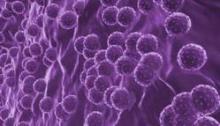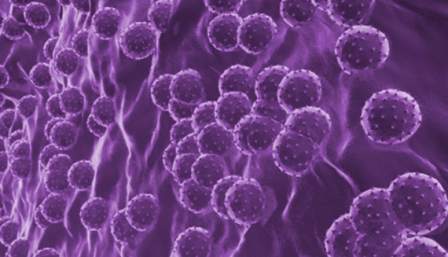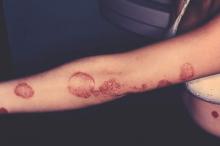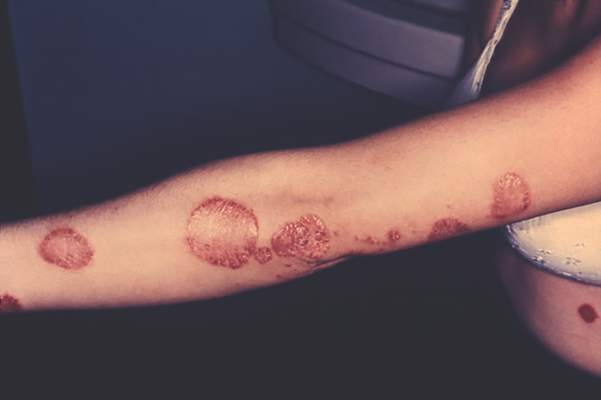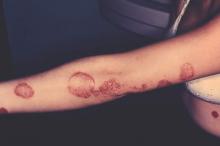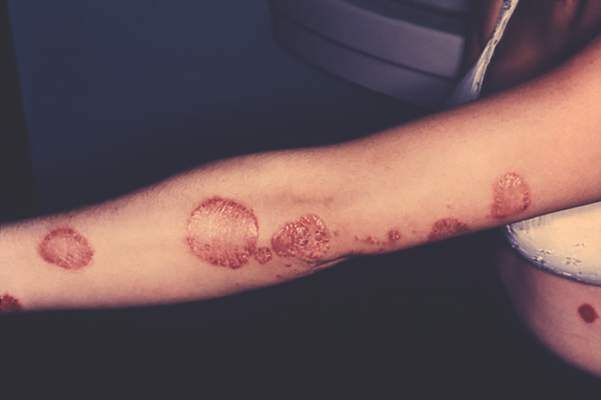User login
Sofosbuvir-velpatasvir combo effective in all HCV genotypes
A once-daily, fixed-dose combination of sofosbuvir (SOF) plus velpatasvir (VEL) had high success rates for the treatment of all six genotypes of hepatitis C virus, manufacturer Gilead Sciences reported.
In three of four phase III trials (ASTRAL-1, ASTRAL-2, and ASTRAL-3), 1,035 HCV patients were given the drug combination for 12 weeks. In the fourth trial (ASTRAL-4), 267 HCV patients with decompensated cirrhosis were randomized to receive either the SOF/VEL combination for 12 weeks with or without ribavirin or 24 weeks of just SOF/VEL. The primary efficacy endpoint for all studies was a sustained virological response at 12 weeks, the company said in a statement.
Results showed that 98% of patients in the first three trials achieved the efficacy endpoint. In the ASTRAL-4 study, 94% of patients in the SOF/VEL plus ribavirin group achieved sustained virological response at 12 weeks. The rates of success in patients receiving the SOF/VEL combination for 12 or 24 weeks were 83% and 86%, respectively. The most common adverse effects were fatigue, nausea, and headache.
The FDA has designated the SOF/VEL combination as “breakthrough therapy” status, granted to “investigational medicines that may offer major advances in treatment over existing options,” the statement said.
A once-daily, fixed-dose combination of sofosbuvir (SOF) plus velpatasvir (VEL) had high success rates for the treatment of all six genotypes of hepatitis C virus, manufacturer Gilead Sciences reported.
In three of four phase III trials (ASTRAL-1, ASTRAL-2, and ASTRAL-3), 1,035 HCV patients were given the drug combination for 12 weeks. In the fourth trial (ASTRAL-4), 267 HCV patients with decompensated cirrhosis were randomized to receive either the SOF/VEL combination for 12 weeks with or without ribavirin or 24 weeks of just SOF/VEL. The primary efficacy endpoint for all studies was a sustained virological response at 12 weeks, the company said in a statement.
Results showed that 98% of patients in the first three trials achieved the efficacy endpoint. In the ASTRAL-4 study, 94% of patients in the SOF/VEL plus ribavirin group achieved sustained virological response at 12 weeks. The rates of success in patients receiving the SOF/VEL combination for 12 or 24 weeks were 83% and 86%, respectively. The most common adverse effects were fatigue, nausea, and headache.
The FDA has designated the SOF/VEL combination as “breakthrough therapy” status, granted to “investigational medicines that may offer major advances in treatment over existing options,” the statement said.
A once-daily, fixed-dose combination of sofosbuvir (SOF) plus velpatasvir (VEL) had high success rates for the treatment of all six genotypes of hepatitis C virus, manufacturer Gilead Sciences reported.
In three of four phase III trials (ASTRAL-1, ASTRAL-2, and ASTRAL-3), 1,035 HCV patients were given the drug combination for 12 weeks. In the fourth trial (ASTRAL-4), 267 HCV patients with decompensated cirrhosis were randomized to receive either the SOF/VEL combination for 12 weeks with or without ribavirin or 24 weeks of just SOF/VEL. The primary efficacy endpoint for all studies was a sustained virological response at 12 weeks, the company said in a statement.
Results showed that 98% of patients in the first three trials achieved the efficacy endpoint. In the ASTRAL-4 study, 94% of patients in the SOF/VEL plus ribavirin group achieved sustained virological response at 12 weeks. The rates of success in patients receiving the SOF/VEL combination for 12 or 24 weeks were 83% and 86%, respectively. The most common adverse effects were fatigue, nausea, and headache.
The FDA has designated the SOF/VEL combination as “breakthrough therapy” status, granted to “investigational medicines that may offer major advances in treatment over existing options,” the statement said.
Guidelines for AD management differ among health groups
Numerous differences exist between dermatology groups on treatment for atopic dermatitis (AD), report Girish C. Mohan and Dr. Peter A. Lio.
A clinical review of AD management guidelines from seven international dermatology organizations found that, although basic guidelines for first-line topical and systemic treatment are similar, “notable differences” were found on guidelines for adjunctive therapies such as diluted bleach baths, vitamin D, and environmental modifications.
“The juxtaposition of different guidelines can enhance individualization of treatment for a patient with AD by drawing from different disciplines with varying traditions and perspectives,” the investigators said in the report.
Read the full review in JAMA Dermatology.
Numerous differences exist between dermatology groups on treatment for atopic dermatitis (AD), report Girish C. Mohan and Dr. Peter A. Lio.
A clinical review of AD management guidelines from seven international dermatology organizations found that, although basic guidelines for first-line topical and systemic treatment are similar, “notable differences” were found on guidelines for adjunctive therapies such as diluted bleach baths, vitamin D, and environmental modifications.
“The juxtaposition of different guidelines can enhance individualization of treatment for a patient with AD by drawing from different disciplines with varying traditions and perspectives,” the investigators said in the report.
Read the full review in JAMA Dermatology.
Numerous differences exist between dermatology groups on treatment for atopic dermatitis (AD), report Girish C. Mohan and Dr. Peter A. Lio.
A clinical review of AD management guidelines from seven international dermatology organizations found that, although basic guidelines for first-line topical and systemic treatment are similar, “notable differences” were found on guidelines for adjunctive therapies such as diluted bleach baths, vitamin D, and environmental modifications.
“The juxtaposition of different guidelines can enhance individualization of treatment for a patient with AD by drawing from different disciplines with varying traditions and perspectives,” the investigators said in the report.
Read the full review in JAMA Dermatology.
Study links childhood type 1 diabetes to increased AD risk
Type 1 diabetes in childhood may increase the risk of subsequent atopic dermatitis (AD), according to Dr. C.H. Lin of Children’s Hospital at China Medical University Hospital in Taichung, Taiwan.
In a population-based, retrospective cohort study of 3,386 patients with type 1 diabetes and 12,725 matched controls, the overall AD incidence rate was 1.4 times higher in the diabetes group at follow-up than in the control group (3.31 vs. 2.35 per 1000 person-years, respectively).
After adjustment for potential risk factors, the AD risk was still significantly higher in patients with diabetes (adjusted hazard ratio = 1.76), reported Dr. Lin and coauthors.
Read the article here in the British Journal of Dermatology.
Type 1 diabetes in childhood may increase the risk of subsequent atopic dermatitis (AD), according to Dr. C.H. Lin of Children’s Hospital at China Medical University Hospital in Taichung, Taiwan.
In a population-based, retrospective cohort study of 3,386 patients with type 1 diabetes and 12,725 matched controls, the overall AD incidence rate was 1.4 times higher in the diabetes group at follow-up than in the control group (3.31 vs. 2.35 per 1000 person-years, respectively).
After adjustment for potential risk factors, the AD risk was still significantly higher in patients with diabetes (adjusted hazard ratio = 1.76), reported Dr. Lin and coauthors.
Read the article here in the British Journal of Dermatology.
Type 1 diabetes in childhood may increase the risk of subsequent atopic dermatitis (AD), according to Dr. C.H. Lin of Children’s Hospital at China Medical University Hospital in Taichung, Taiwan.
In a population-based, retrospective cohort study of 3,386 patients with type 1 diabetes and 12,725 matched controls, the overall AD incidence rate was 1.4 times higher in the diabetes group at follow-up than in the control group (3.31 vs. 2.35 per 1000 person-years, respectively).
After adjustment for potential risk factors, the AD risk was still significantly higher in patients with diabetes (adjusted hazard ratio = 1.76), reported Dr. Lin and coauthors.
Read the article here in the British Journal of Dermatology.
Joint Commission launches educational campaign on antibiotic use
The Joint Commission has introduced a multimedia campaign to educate the public on the health risks associated with antibiotic overuse, the group announced Sept. 14.
The Speak Up: Antibiotics program aims to educate consumers on appropriate use of antibiotics, and includes resources to help patients determine which illnesses may or may not need antibiotic treatment. The website includes an infographic, podcast, and animated video.
The initiative is part of the Speak Up series, a program that encourages patients to become more active in their medical decisions through self-education and advocacy.
About 2 million people in the United States become infected with antibiotic-resistant bacteria each year, the Joint Commission reported.
“Antibiotics also can kill good bacteria in the body, potentially leading to other problems such as diarrhea or yeast infections,” the organization said in a statement. “As a result, antibiotic overuse has become a critical health and patient safety concern, especially in young children and seniors, who are at higher risk for illness.”
Click here for more information on the Speak Up: Antibiotics campaign.
The Joint Commission has introduced a multimedia campaign to educate the public on the health risks associated with antibiotic overuse, the group announced Sept. 14.
The Speak Up: Antibiotics program aims to educate consumers on appropriate use of antibiotics, and includes resources to help patients determine which illnesses may or may not need antibiotic treatment. The website includes an infographic, podcast, and animated video.
The initiative is part of the Speak Up series, a program that encourages patients to become more active in their medical decisions through self-education and advocacy.
About 2 million people in the United States become infected with antibiotic-resistant bacteria each year, the Joint Commission reported.
“Antibiotics also can kill good bacteria in the body, potentially leading to other problems such as diarrhea or yeast infections,” the organization said in a statement. “As a result, antibiotic overuse has become a critical health and patient safety concern, especially in young children and seniors, who are at higher risk for illness.”
Click here for more information on the Speak Up: Antibiotics campaign.
The Joint Commission has introduced a multimedia campaign to educate the public on the health risks associated with antibiotic overuse, the group announced Sept. 14.
The Speak Up: Antibiotics program aims to educate consumers on appropriate use of antibiotics, and includes resources to help patients determine which illnesses may or may not need antibiotic treatment. The website includes an infographic, podcast, and animated video.
The initiative is part of the Speak Up series, a program that encourages patients to become more active in their medical decisions through self-education and advocacy.
About 2 million people in the United States become infected with antibiotic-resistant bacteria each year, the Joint Commission reported.
“Antibiotics also can kill good bacteria in the body, potentially leading to other problems such as diarrhea or yeast infections,” the organization said in a statement. “As a result, antibiotic overuse has become a critical health and patient safety concern, especially in young children and seniors, who are at higher risk for illness.”
Click here for more information on the Speak Up: Antibiotics campaign.
Peripartum Probiotics Linked to Lower Atopic Dermatitis Risk in Offspring
Peripartum consumption of probiotic milk was associated with a decline in the incidence of atopic dermatitis in offspring, but other allergy-related diseases were not reduced in the children, the results of a randomized study indicate.
In a randomized study, 415 pregnant women drank eiher probiotic or placebo milk from 36 weeks’ gestation to 3 months postpartum. At 6 years follow-up, there was a lower cumulative incidence of AD in the probiotic group compared with the placebo group (OR = 0.64; 95% CI 0.39-1.07; p = .086; NNT = 10), Dr. Melanie Rae Simpson and coauthors from the Department of Public Health and General Practice Faculty of Medicine at the Norwegian University of Science and Technology in Trondheim, reported.
The children’s incidence of other allergy related diseases, including asthma, atopic sensitization, and allergic rhinoconjunctivitis, were not significantly changed by probiotic use, the investigators said in the report.
The findings suggest that perinatal probiotics prevent, rather than merely delay, the onset of childhood atopic dermatitis, the authors concluded.
Read the full article in BMC Dermatology.
Peripartum consumption of probiotic milk was associated with a decline in the incidence of atopic dermatitis in offspring, but other allergy-related diseases were not reduced in the children, the results of a randomized study indicate.
In a randomized study, 415 pregnant women drank eiher probiotic or placebo milk from 36 weeks’ gestation to 3 months postpartum. At 6 years follow-up, there was a lower cumulative incidence of AD in the probiotic group compared with the placebo group (OR = 0.64; 95% CI 0.39-1.07; p = .086; NNT = 10), Dr. Melanie Rae Simpson and coauthors from the Department of Public Health and General Practice Faculty of Medicine at the Norwegian University of Science and Technology in Trondheim, reported.
The children’s incidence of other allergy related diseases, including asthma, atopic sensitization, and allergic rhinoconjunctivitis, were not significantly changed by probiotic use, the investigators said in the report.
The findings suggest that perinatal probiotics prevent, rather than merely delay, the onset of childhood atopic dermatitis, the authors concluded.
Read the full article in BMC Dermatology.
Peripartum consumption of probiotic milk was associated with a decline in the incidence of atopic dermatitis in offspring, but other allergy-related diseases were not reduced in the children, the results of a randomized study indicate.
In a randomized study, 415 pregnant women drank eiher probiotic or placebo milk from 36 weeks’ gestation to 3 months postpartum. At 6 years follow-up, there was a lower cumulative incidence of AD in the probiotic group compared with the placebo group (OR = 0.64; 95% CI 0.39-1.07; p = .086; NNT = 10), Dr. Melanie Rae Simpson and coauthors from the Department of Public Health and General Practice Faculty of Medicine at the Norwegian University of Science and Technology in Trondheim, reported.
The children’s incidence of other allergy related diseases, including asthma, atopic sensitization, and allergic rhinoconjunctivitis, were not significantly changed by probiotic use, the investigators said in the report.
The findings suggest that perinatal probiotics prevent, rather than merely delay, the onset of childhood atopic dermatitis, the authors concluded.
Read the full article in BMC Dermatology.
Peripartum probiotics linked to lower atopic dermatitis risk in offspring
Peripartum consumption of probiotic milk was associated with a decline in the incidence of atopic dermatitis in offspring, but other allergy-related diseases were not reduced in the children, the results of a randomized study indicate.
In a randomized study, 415 pregnant women drank eiher probiotic or placebo milk from 36 weeks’ gestation to 3 months postpartum. At 6 years follow-up, there was a lower cumulative incidence of AD in the probiotic group compared with the placebo group (OR = 0.64; 95% CI 0.39-1.07; p = .086; NNT = 10), Dr. Melanie Rae Simpson and coauthors from the Department of Public Health and General Practice Faculty of Medicine at the Norwegian University of Science and Technology in Trondheim, reported.
The children’s incidence of other allergy related diseases, including asthma, atopic sensitization, and allergic rhinoconjunctivitis, were not significantly changed by probiotic use, the investigators said in the report.
The findings suggest that perinatal probiotics prevent, rather than merely delay, the onset of childhood atopic dermatitis, the authors concluded.
Read the full article in BMC Dermatology.
Peripartum consumption of probiotic milk was associated with a decline in the incidence of atopic dermatitis in offspring, but other allergy-related diseases were not reduced in the children, the results of a randomized study indicate.
In a randomized study, 415 pregnant women drank eiher probiotic or placebo milk from 36 weeks’ gestation to 3 months postpartum. At 6 years follow-up, there was a lower cumulative incidence of AD in the probiotic group compared with the placebo group (OR = 0.64; 95% CI 0.39-1.07; p = .086; NNT = 10), Dr. Melanie Rae Simpson and coauthors from the Department of Public Health and General Practice Faculty of Medicine at the Norwegian University of Science and Technology in Trondheim, reported.
The children’s incidence of other allergy related diseases, including asthma, atopic sensitization, and allergic rhinoconjunctivitis, were not significantly changed by probiotic use, the investigators said in the report.
The findings suggest that perinatal probiotics prevent, rather than merely delay, the onset of childhood atopic dermatitis, the authors concluded.
Read the full article in BMC Dermatology.
Peripartum consumption of probiotic milk was associated with a decline in the incidence of atopic dermatitis in offspring, but other allergy-related diseases were not reduced in the children, the results of a randomized study indicate.
In a randomized study, 415 pregnant women drank eiher probiotic or placebo milk from 36 weeks’ gestation to 3 months postpartum. At 6 years follow-up, there was a lower cumulative incidence of AD in the probiotic group compared with the placebo group (OR = 0.64; 95% CI 0.39-1.07; p = .086; NNT = 10), Dr. Melanie Rae Simpson and coauthors from the Department of Public Health and General Practice Faculty of Medicine at the Norwegian University of Science and Technology in Trondheim, reported.
The children’s incidence of other allergy related diseases, including asthma, atopic sensitization, and allergic rhinoconjunctivitis, were not significantly changed by probiotic use, the investigators said in the report.
The findings suggest that perinatal probiotics prevent, rather than merely delay, the onset of childhood atopic dermatitis, the authors concluded.
Read the full article in BMC Dermatology.
Psoriasis and Herpes Are Most Stigmatized Dermatologic Conditions
Attitudes toward psoriasis and herpes are significantly more stigmatizing than are perceptions of other dermatologic conditions, reported Dr. Jessica M. Donigan and her associates from Massachusetts General Hospital in Boston.
In a survey of 56 adults without any skin conditions aside from typical teenage acne, investigators used an image-based questionnaire to assess attitudes toward psoriasis, compared with other skin conditions such as atopic dermatitis, acne, vitiligo, rosacea, herpes labialis, warts, and tinea versicolor. At least 48% of respondents reported feeling upset by images of psoriasis, although significantly more were upset by images of herpes. Additionally, about 61% believed psoriasis had an infectious cause, with 41% of participants thinking psoriasis lesions looked contagious because of scale, color, and size, the authors reported.
A total of 39% of respondents thought herpes was the most-bothersome skin disease, compared with 30% for psoriasis, although this difference was not significant (P = .42). As many as 86% said they would feel pity if they saw a person with psoriasis, which was significantly greater for any of the other dermatologic conditions except acne, the investigators said.
The findings suggest that “misconceptions of infection and contagion, and feelings of pity cause psoriasis to be as bothersome as herpes labialis,” Dr. Donigan and her colleagues said.
Additionally, despite participants perceiving the two conditions as similarly bothersome, psoriasis may “have a greater overall impact on quality of life because of its continuity and chronicity,” they said. “Because of its potential lifelong impact, it is important to familiarize the public with psoriasis to aid in destigmatization.”
Read the full report in the Journal of the American Academy of Dermatology.
Attitudes toward psoriasis and herpes are significantly more stigmatizing than are perceptions of other dermatologic conditions, reported Dr. Jessica M. Donigan and her associates from Massachusetts General Hospital in Boston.
In a survey of 56 adults without any skin conditions aside from typical teenage acne, investigators used an image-based questionnaire to assess attitudes toward psoriasis, compared with other skin conditions such as atopic dermatitis, acne, vitiligo, rosacea, herpes labialis, warts, and tinea versicolor. At least 48% of respondents reported feeling upset by images of psoriasis, although significantly more were upset by images of herpes. Additionally, about 61% believed psoriasis had an infectious cause, with 41% of participants thinking psoriasis lesions looked contagious because of scale, color, and size, the authors reported.
A total of 39% of respondents thought herpes was the most-bothersome skin disease, compared with 30% for psoriasis, although this difference was not significant (P = .42). As many as 86% said they would feel pity if they saw a person with psoriasis, which was significantly greater for any of the other dermatologic conditions except acne, the investigators said.
The findings suggest that “misconceptions of infection and contagion, and feelings of pity cause psoriasis to be as bothersome as herpes labialis,” Dr. Donigan and her colleagues said.
Additionally, despite participants perceiving the two conditions as similarly bothersome, psoriasis may “have a greater overall impact on quality of life because of its continuity and chronicity,” they said. “Because of its potential lifelong impact, it is important to familiarize the public with psoriasis to aid in destigmatization.”
Read the full report in the Journal of the American Academy of Dermatology.
Attitudes toward psoriasis and herpes are significantly more stigmatizing than are perceptions of other dermatologic conditions, reported Dr. Jessica M. Donigan and her associates from Massachusetts General Hospital in Boston.
In a survey of 56 adults without any skin conditions aside from typical teenage acne, investigators used an image-based questionnaire to assess attitudes toward psoriasis, compared with other skin conditions such as atopic dermatitis, acne, vitiligo, rosacea, herpes labialis, warts, and tinea versicolor. At least 48% of respondents reported feeling upset by images of psoriasis, although significantly more were upset by images of herpes. Additionally, about 61% believed psoriasis had an infectious cause, with 41% of participants thinking psoriasis lesions looked contagious because of scale, color, and size, the authors reported.
A total of 39% of respondents thought herpes was the most-bothersome skin disease, compared with 30% for psoriasis, although this difference was not significant (P = .42). As many as 86% said they would feel pity if they saw a person with psoriasis, which was significantly greater for any of the other dermatologic conditions except acne, the investigators said.
The findings suggest that “misconceptions of infection and contagion, and feelings of pity cause psoriasis to be as bothersome as herpes labialis,” Dr. Donigan and her colleagues said.
Additionally, despite participants perceiving the two conditions as similarly bothersome, psoriasis may “have a greater overall impact on quality of life because of its continuity and chronicity,” they said. “Because of its potential lifelong impact, it is important to familiarize the public with psoriasis to aid in destigmatization.”
Read the full report in the Journal of the American Academy of Dermatology.
Psoriasis and herpes are most stigmatized dermatologic conditions
Attitudes toward psoriasis and herpes are significantly more stigmatizing than are perceptions of other dermatologic conditions, reported Dr. Jessica M. Donigan and her associates from Massachusetts General Hospital in Boston.
In a survey of 56 adults without any skin conditions aside from typical teenage acne, investigators used an image-based questionnaire to assess attitudes toward psoriasis, compared with other skin conditions such as atopic dermatitis, acne, vitiligo, rosacea, herpes labialis, warts, and tinea versicolor. At least 48% of respondents reported feeling upset by images of psoriasis, although significantly more were upset by images of herpes. Additionally, about 61% believed psoriasis had an infectious cause, with 41% of participants thinking psoriasis lesions looked contagious because of scale, color, and size, the authors reported.
A total of 39% of respondents thought herpes was the most-bothersome skin disease, compared with 30% for psoriasis, although this difference was not significant (P = .42). As many as 86% said they would feel pity if they saw a person with psoriasis, which was significantly greater for any of the other dermatologic conditions except acne, the investigators said.
The findings suggest that “misconceptions of infection and contagion, and feelings of pity cause psoriasis to be as bothersome as herpes labialis,” Dr. Donigan and her colleagues said.
Additionally, despite participants perceiving the two conditions as similarly bothersome, psoriasis may “have a greater overall impact on quality of life because of its continuity and chronicity,” they said. “Because of its potential lifelong impact, it is important to familiarize the public with psoriasis to aid in destigmatization.”
Read the full report in the Journal of the American Academy of Dermatology.
Attitudes toward psoriasis and herpes are significantly more stigmatizing than are perceptions of other dermatologic conditions, reported Dr. Jessica M. Donigan and her associates from Massachusetts General Hospital in Boston.
In a survey of 56 adults without any skin conditions aside from typical teenage acne, investigators used an image-based questionnaire to assess attitudes toward psoriasis, compared with other skin conditions such as atopic dermatitis, acne, vitiligo, rosacea, herpes labialis, warts, and tinea versicolor. At least 48% of respondents reported feeling upset by images of psoriasis, although significantly more were upset by images of herpes. Additionally, about 61% believed psoriasis had an infectious cause, with 41% of participants thinking psoriasis lesions looked contagious because of scale, color, and size, the authors reported.
A total of 39% of respondents thought herpes was the most-bothersome skin disease, compared with 30% for psoriasis, although this difference was not significant (P = .42). As many as 86% said they would feel pity if they saw a person with psoriasis, which was significantly greater for any of the other dermatologic conditions except acne, the investigators said.
The findings suggest that “misconceptions of infection and contagion, and feelings of pity cause psoriasis to be as bothersome as herpes labialis,” Dr. Donigan and her colleagues said.
Additionally, despite participants perceiving the two conditions as similarly bothersome, psoriasis may “have a greater overall impact on quality of life because of its continuity and chronicity,” they said. “Because of its potential lifelong impact, it is important to familiarize the public with psoriasis to aid in destigmatization.”
Read the full report in the Journal of the American Academy of Dermatology.
Attitudes toward psoriasis and herpes are significantly more stigmatizing than are perceptions of other dermatologic conditions, reported Dr. Jessica M. Donigan and her associates from Massachusetts General Hospital in Boston.
In a survey of 56 adults without any skin conditions aside from typical teenage acne, investigators used an image-based questionnaire to assess attitudes toward psoriasis, compared with other skin conditions such as atopic dermatitis, acne, vitiligo, rosacea, herpes labialis, warts, and tinea versicolor. At least 48% of respondents reported feeling upset by images of psoriasis, although significantly more were upset by images of herpes. Additionally, about 61% believed psoriasis had an infectious cause, with 41% of participants thinking psoriasis lesions looked contagious because of scale, color, and size, the authors reported.
A total of 39% of respondents thought herpes was the most-bothersome skin disease, compared with 30% for psoriasis, although this difference was not significant (P = .42). As many as 86% said they would feel pity if they saw a person with psoriasis, which was significantly greater for any of the other dermatologic conditions except acne, the investigators said.
The findings suggest that “misconceptions of infection and contagion, and feelings of pity cause psoriasis to be as bothersome as herpes labialis,” Dr. Donigan and her colleagues said.
Additionally, despite participants perceiving the two conditions as similarly bothersome, psoriasis may “have a greater overall impact on quality of life because of its continuity and chronicity,” they said. “Because of its potential lifelong impact, it is important to familiarize the public with psoriasis to aid in destigmatization.”
Read the full report in the Journal of the American Academy of Dermatology.
Screen for depression in adolescents, USPSTF recommends
The U.S. Preventive Services Task Force has issued a grade B recommendation in support of depression screening in adolescents aged 12-18 years when “adequate systems are in place for diagnosis, treatment, and monitoring,” the group announced Sept. 7.
The draft reaffirms the 2009 USPSTF recommendation but eliminates the suggestion of specific therapies, such as cognitive behavioral therapy (CBT), because of decreased concern over the harms of antidepressant medication in adolescent patients.
“Although the data are limited, the USPSTF concludes that the evidence on the frequency of medication-related adverse events in adolescents is adequate to estimate that the magnitude of harms of pharmacotherapy is small if patients are closely monitored,” the statement said.
The new recommendation also reaffirms the 2009 stance that current evidence is insufficient to make a recommendation for children aged 7-11 years.
Results from two national surveys found that about 8% of adolescents reported having major depressive disorder (MDD) in the past year, with a mean onset age of 14-15 years, the USPSTF noted.
“Children and adolescents with MDD typically have functional impairments in their performance at school or work, as well as in their interactions with their families and peers,” the statement said. “Depression can also negatively affect the developmental trajectories of affected youth.”
Additionally, depression in childhood and adolescence is strongly associated with recurrent depression in adulthood, other comorbid psychiatric disorders, and increased risk for suicide attempts and completion, the statement said.
Four studies included in a USPSTF review reported superior efficacy with selective serotonin reuptake inhibitor treatment, compared with placebo, with the absolute difference in response ranging from 2.4% to 25%. Results were statistically significant in two of the four trials, the task force reported.
In addition, two studies that evaluated CBT found nonstatistically significant improvements in response, compared with placebo (43.2% vs. 34.8%).
A separate trial, which compared combined CBT plus fluoxetine treatment with placebo, found that CBT plus fluoxetine showed a 71% response rate, compared with 35% in the placebo group (P = .001), the USPSTF said.
The task force reported no direct evidence on the harms of screening.
“Only 36% to 44% of children and adolescents with depression receive treatment, suggesting that the majority of depressed youth are undiagnosed and untreated,” the USPSTF said.
Findings show that “screening tests can accurately identify MDD in adolescents” and that “treatment of adolescents identified through screening is associated with beneficial reductions in MDD symptoms,” the task force concluded.
The draft recommendation is open for public comment on the USPSTF website until Oct. 5.
The U.S. Preventive Services Task Force has issued a grade B recommendation in support of depression screening in adolescents aged 12-18 years when “adequate systems are in place for diagnosis, treatment, and monitoring,” the group announced Sept. 7.
The draft reaffirms the 2009 USPSTF recommendation but eliminates the suggestion of specific therapies, such as cognitive behavioral therapy (CBT), because of decreased concern over the harms of antidepressant medication in adolescent patients.
“Although the data are limited, the USPSTF concludes that the evidence on the frequency of medication-related adverse events in adolescents is adequate to estimate that the magnitude of harms of pharmacotherapy is small if patients are closely monitored,” the statement said.
The new recommendation also reaffirms the 2009 stance that current evidence is insufficient to make a recommendation for children aged 7-11 years.
Results from two national surveys found that about 8% of adolescents reported having major depressive disorder (MDD) in the past year, with a mean onset age of 14-15 years, the USPSTF noted.
“Children and adolescents with MDD typically have functional impairments in their performance at school or work, as well as in their interactions with their families and peers,” the statement said. “Depression can also negatively affect the developmental trajectories of affected youth.”
Additionally, depression in childhood and adolescence is strongly associated with recurrent depression in adulthood, other comorbid psychiatric disorders, and increased risk for suicide attempts and completion, the statement said.
Four studies included in a USPSTF review reported superior efficacy with selective serotonin reuptake inhibitor treatment, compared with placebo, with the absolute difference in response ranging from 2.4% to 25%. Results were statistically significant in two of the four trials, the task force reported.
In addition, two studies that evaluated CBT found nonstatistically significant improvements in response, compared with placebo (43.2% vs. 34.8%).
A separate trial, which compared combined CBT plus fluoxetine treatment with placebo, found that CBT plus fluoxetine showed a 71% response rate, compared with 35% in the placebo group (P = .001), the USPSTF said.
The task force reported no direct evidence on the harms of screening.
“Only 36% to 44% of children and adolescents with depression receive treatment, suggesting that the majority of depressed youth are undiagnosed and untreated,” the USPSTF said.
Findings show that “screening tests can accurately identify MDD in adolescents” and that “treatment of adolescents identified through screening is associated with beneficial reductions in MDD symptoms,” the task force concluded.
The draft recommendation is open for public comment on the USPSTF website until Oct. 5.
The U.S. Preventive Services Task Force has issued a grade B recommendation in support of depression screening in adolescents aged 12-18 years when “adequate systems are in place for diagnosis, treatment, and monitoring,” the group announced Sept. 7.
The draft reaffirms the 2009 USPSTF recommendation but eliminates the suggestion of specific therapies, such as cognitive behavioral therapy (CBT), because of decreased concern over the harms of antidepressant medication in adolescent patients.
“Although the data are limited, the USPSTF concludes that the evidence on the frequency of medication-related adverse events in adolescents is adequate to estimate that the magnitude of harms of pharmacotherapy is small if patients are closely monitored,” the statement said.
The new recommendation also reaffirms the 2009 stance that current evidence is insufficient to make a recommendation for children aged 7-11 years.
Results from two national surveys found that about 8% of adolescents reported having major depressive disorder (MDD) in the past year, with a mean onset age of 14-15 years, the USPSTF noted.
“Children and adolescents with MDD typically have functional impairments in their performance at school or work, as well as in their interactions with their families and peers,” the statement said. “Depression can also negatively affect the developmental trajectories of affected youth.”
Additionally, depression in childhood and adolescence is strongly associated with recurrent depression in adulthood, other comorbid psychiatric disorders, and increased risk for suicide attempts and completion, the statement said.
Four studies included in a USPSTF review reported superior efficacy with selective serotonin reuptake inhibitor treatment, compared with placebo, with the absolute difference in response ranging from 2.4% to 25%. Results were statistically significant in two of the four trials, the task force reported.
In addition, two studies that evaluated CBT found nonstatistically significant improvements in response, compared with placebo (43.2% vs. 34.8%).
A separate trial, which compared combined CBT plus fluoxetine treatment with placebo, found that CBT plus fluoxetine showed a 71% response rate, compared with 35% in the placebo group (P = .001), the USPSTF said.
The task force reported no direct evidence on the harms of screening.
“Only 36% to 44% of children and adolescents with depression receive treatment, suggesting that the majority of depressed youth are undiagnosed and untreated,” the USPSTF said.
Findings show that “screening tests can accurately identify MDD in adolescents” and that “treatment of adolescents identified through screening is associated with beneficial reductions in MDD symptoms,” the task force concluded.
The draft recommendation is open for public comment on the USPSTF website until Oct. 5.
Sexual well-being impaired in women with vulvar disease
Women with vulvar disease experience impaired sexual well-being compared with their healthy counterparts, report Dr. Sophie Wylomanski and coauthors from the department of gynecology and obstetrics at Nantes (France) University Hospital.
In a study of 72 women with vulvar disease and 72 controls who completed the Female Sexual Function Index (FSFI) assessment, the median FSFI score was 21.1 in the vulvar disease patients, compared with 28.1 in the control group. The sexual function scores were significantly lower in the vulvar disease group – by an average of 4.5 points – when multivariate analysis was performed (P = .003), Dr. Wylomanski and associates said.
FSFI subscores showed that vulvar disease had a significant effect on arousal, pain, lubrication, satisfaction, and desire. Scores “seemed lower” for premalignant vulvar disease when compared with inflammatory, infectious, and other disease types, the investigators reported.
Read the full article in the European Journal of Obstetrics & Gynecology and Reproductive Biology (doi: 10.1016/j.ejogrb.2015.08.011).
Women with vulvar disease experience impaired sexual well-being compared with their healthy counterparts, report Dr. Sophie Wylomanski and coauthors from the department of gynecology and obstetrics at Nantes (France) University Hospital.
In a study of 72 women with vulvar disease and 72 controls who completed the Female Sexual Function Index (FSFI) assessment, the median FSFI score was 21.1 in the vulvar disease patients, compared with 28.1 in the control group. The sexual function scores were significantly lower in the vulvar disease group – by an average of 4.5 points – when multivariate analysis was performed (P = .003), Dr. Wylomanski and associates said.
FSFI subscores showed that vulvar disease had a significant effect on arousal, pain, lubrication, satisfaction, and desire. Scores “seemed lower” for premalignant vulvar disease when compared with inflammatory, infectious, and other disease types, the investigators reported.
Read the full article in the European Journal of Obstetrics & Gynecology and Reproductive Biology (doi: 10.1016/j.ejogrb.2015.08.011).
Women with vulvar disease experience impaired sexual well-being compared with their healthy counterparts, report Dr. Sophie Wylomanski and coauthors from the department of gynecology and obstetrics at Nantes (France) University Hospital.
In a study of 72 women with vulvar disease and 72 controls who completed the Female Sexual Function Index (FSFI) assessment, the median FSFI score was 21.1 in the vulvar disease patients, compared with 28.1 in the control group. The sexual function scores were significantly lower in the vulvar disease group – by an average of 4.5 points – when multivariate analysis was performed (P = .003), Dr. Wylomanski and associates said.
FSFI subscores showed that vulvar disease had a significant effect on arousal, pain, lubrication, satisfaction, and desire. Scores “seemed lower” for premalignant vulvar disease when compared with inflammatory, infectious, and other disease types, the investigators reported.
Read the full article in the European Journal of Obstetrics & Gynecology and Reproductive Biology (doi: 10.1016/j.ejogrb.2015.08.011).
